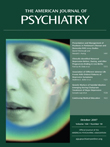Two Primary Configurations of Psychopathology and Change in Thought Disorder in Long-Term Intensive Inpatient Treatment of Seriously Disturbed Young Adults
Abstract
Objective: Change in three types of thought disorder as measured by Rorschach responses (contaminations, confabulations, and fabulized combinations) were assessed during intensive, long-term, psychodynamically oriented inpatient treatment. Method: Rorschach protocols for 90 seriously disturbed, treatment-resistant patients, 42 of whom were primarily preoccupied with primitive issues of interpersonal relatedness and used avoidant defenses (anaclitic patients) and 48 primarily preoccupied with primitive issues of self-definition and self-worth and used counteractive defenses (introjective patients), were evaluated at the beginning of treatment and, on average, 15 months into treatment. Results: Change in anaclitic patients occurred primarily in more pathological forms of thought disorder (contaminations and confabulations) that express boundary disturbances; change in introjective patients occurred primarily in the less disturbed thought disorder (fabulized combinations) that expresses tendencies toward referential thinking. Conclusions: Seriously disturbed anaclitic and introjective patients expressed therapeutic progress in different but theoretically consistent ways.



